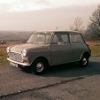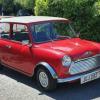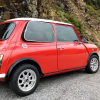
Ball Joints - How Tight?
#31

Posted 18 November 2021 - 10:40 AM
Allan
#32

Posted 18 November 2021 - 06:37 PM
Just to revitalise this thread.....how many mini owners have expirenced front swivel joint breakage on their cars does anybody know how common it is for the swivel joints to snap off ? Just thought I'd ask.
Allan
Not quite the answer(s) to your question here, but the Lower Joint can break if any negative amounts of camber is dialed in. In stock form, at full droop, the lower joint gets right to the position of the Pin locking against the Cap, thus preventing any further roll movement and going to a bending action.
The factory advice (though they don't spell out the whys and wherefores very well) is when any Negative Camber is set to pack up the landing pad on the Top Arm where the Rebound (L Pad) Rubber Stop is with 3 mm sheet.
Of course, there can be other causes for breakages.
Just reading through this thread again - my take on how they should be set - based on advice in the factory manual is that some clearance is better than no clearance. They say 'No Nip' to 0.003" End Float '. There seems to be some debate as to what 'no nip' actually means that the Pin is not pinched or grabbed or tight at all.
My interpretation is that you'd screw on the Cap until it touches the ball and any play is gone, this to me doesn't mean tight, it means to just wind it on until any play has gone. Measure the gap between the Cup and Hub, subtract for the Locktab and that should be the thickness of shims needed to get to that same setting then they say to add a further shim so there's no nip to 0.003" play. In other words (again, my interpretation), a looser joint is preferred over tight joint.

(highlighting is of course mine)
I have said it elsewhere in this thread, but I have observed, when fitting tight, the grease just gets wiped away from where there's contact.
I'll add here too, that these type of ball joints are somewhat unique, not only that they need to be built up and shimmed etc on hub, but also the make up of them. These have all steel parts within, so the joint is 'steel on steel' and it seems from my own checks, all parts have a similar hardness. When I sit down and really think about that, these joints really rely on grease in a big way.
Most (all?) Joints on other cars (as illustrated in this thread somewhere else), have a spring loaded seat. The seats too, as best as I am aware, are a 'plastic' seat, so there's a reduction in the metal on metal contact. I'm not certain that a spring loaded seat is a good thing though as the joint can be worn, and they never wear even, they end up with steps worn in them, and this can be quite hard to detect. I guess it can't be too serious and maybe I'm over thinking this as in general, ball joint failures don't seem common on other cars.
#33

Posted 18 November 2021 - 06:40 PM
Steveston Motor Co, has a detailed video on ball joint shimming and how he sets the stiffness. DS3Shooter also made a excellent video on this topic.
0 user(s) are reading this topic
0 members, 0 guests, 0 anonymous users
















